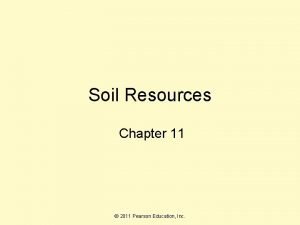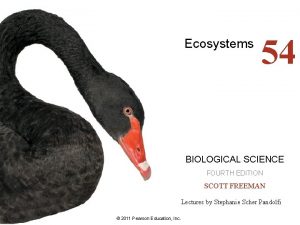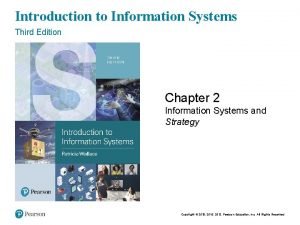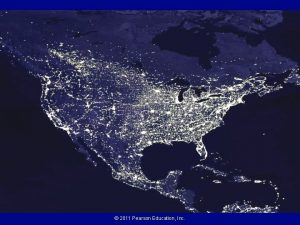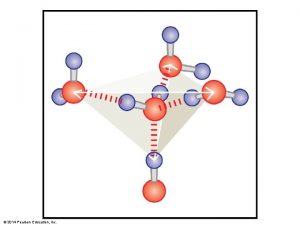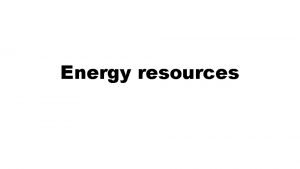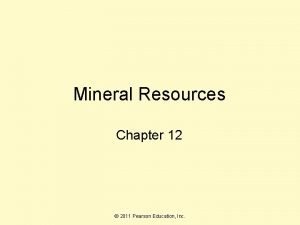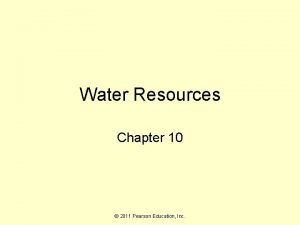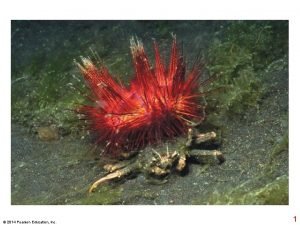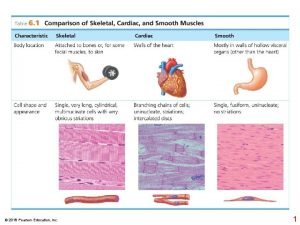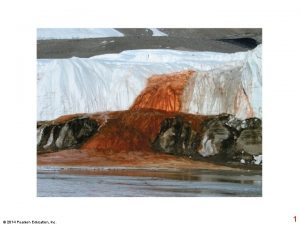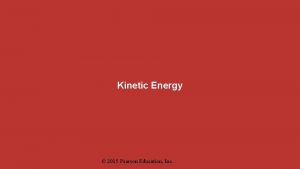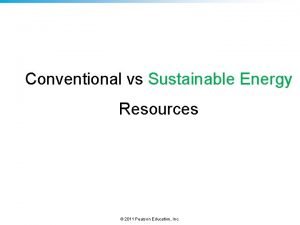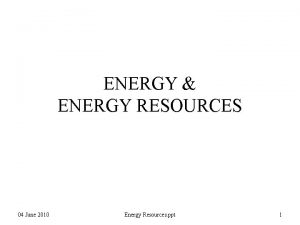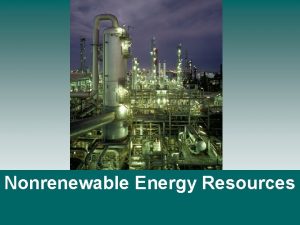Energy Resources Chapter 13 2011 Pearson Education Inc












































- Slides: 44

Energy Resources Chapter 13 © 2011 Pearson Education, Inc.

You will learn • Basic facts about energy, including the nature of energy resources, what Earth systems interactions produce such resources, the history of people’s energy use, and the future of energy supply and demand • Origin of fossil fuels (oil, natural gas, and coal) and environmental concerns associated with their exploration, production, transportation, refining and processing, and consumption • How nuclear energy works, and how nuclear energy is used around the world © 2011 Pearson Education, Inc.

You will learn (cont. ) • Safety and environmental concerns associated with producing nuclear energy • Sources of renewable energy resources (biomass, geothermal, hydropower, wind, and solar) and environmental concerns associated with their use • Future challenges of energy production and use, the role of stewardship and sustainability, and the scope of decisions about energy resource development and use that people will face © 2011 Pearson Education, Inc.

An Oil-dependent World— Supply and Demand Driven • Many countries are dependent on oil and the price of gasoline and diesel fuels derived from crude oil fluctuates with changes in supply and demand. The price of crude oil is the greatest contributor to the cost of fuel globally. Overall demand continues to increase • Oil demand is expected to reach 118 million barrels per day by 2030. Will the Earth be able to supply this needed oil? Figure 13 -2 Rush Hour in Xiamen, China’s oil demand is rising rapidly. It is expected to increase from 2. 5 billion barrels/year in 2006 to 4 billion barrels/year in 2020. © 2011 Pearson Education, Inc.

Oil Reserves—the Supply • Proven reserves = oil that’s economically recoverable today. Main sources are shown in Fig. 13 -3. • In 2000, the USGS estimated the world’s undiscovered oil totals at 649 billion barrels; better recovery from existing fields will add another 612 billion barrels of reserves. Figure 13 -3 Countries with the Greatest Oil Reserves As of January 2007, 11 countries accounted for about 86% of the world’s proven oil reserves of 1317 billion barrels (1 barrel = 42 gallons). © 2011 Pearson Education, Inc.

Peak Oil Production Figure 13 -4 An Estimate of the Time of Global Peak Conventional Oil Production This estimate (blue curve) was made in 2006 by the Association for the Study of Peak Oil and Gas. (ASPO International). The shift from increasing or stable production levels to declining production has been called the “Big Rollover. ” Such a rollover in oil production occurred in the continental U. S. A. in 1970 (red curve). © 2011 Pearson Education, Inc.

Sources of Energy in the U. S. Figure 13 -5 Sources of Energy in the United States Oil, coal, and natural gas, all fossil fuels, make up nearly 85% of energy resources. © 2011 Pearson Education, Inc.

Oil and Gas Formation Figure 13 -6 Precursors of Oil and Gas Microscopic algae like these diatoms are among organisms whose remains give rise to oil and natural gas. Figure 13 -7 How Oil and Natural Gas Form Burial of the remains of tiny marine life in ocean sediments changes them, over time, into oil and natural gas. © 2011 Pearson Education, Inc.

Oil Reservoirs—Traps Required Figure 13 -8 Oil and Gas Traps Over time, oil and natural gas migrate through permeable pathways and into traps. Figure 13 -9 A Natural Oil Seep can occur if traps are not present —Wind River Canyon, Wyoming © 2011 Pearson Education, Inc.

Finding Energy Resources— Oil and Natural Gas Prospecting • Finding hydrocarbon energy resources today typically incorporates seismic surveys prior to drilling a series of wells. Figure 13 -10 The Spindletop Gusher Blowouts were commonly called “gushers” in the early days of oil exploration. © 2011 Pearson Education, Inc. Figure 13 -11 Much Exploration for Oil and Gas Takes Place in Remote Parts of the World A production platform for an oil field, Cook Inlet region of southern Alaska.

Seismic Surveying— A Prospector’s Tool Figure 13 -12 Seismic Surveys • Surveys are conducted both onshore (shown) and offshore • Sound waves or vibrations travel through the geosphere and reflect or refract as they pass through materials with different physical properties • These interactions change the travel path and time it takes for the waves to return to the surface, where geophones record their arrival. • Travel time variations are analyzed by a computer and displayed in ways that enable subsurface geometry and character of rocks to be interpreted © 2011 Pearson Education, Inc.

Exploration Drilling • Drill sites are commonly ~size of a football field or larger. Because only 1 out of 10 exploration wells is successful, infrastructure for exploration drilling is commonly temporary. • After drilling, equipment is removed and disturbed areas can be reclaimed if they have no further use. • If exploration drilling is offshore, it can be done from drill ships, floating rigs, or rigs with support legs that reach to the seafloor. • Exploration drilling (and oil production) have taken place in waters nearly 6100 m (20, 000 ft) deep. Figure 13 -13 An Oil Exploration Drill Site Drilled in the onshore Arctic region of Alaska. Person for scale right of rig in open area. © 2011 Pearson Education, Inc.

Drilling Process and Waste Products • Drilling requires fluids to lubricate the well bore and control pressure in it; fluid is a mixture of water, clay, barite, and chemicals; commonly called drilling mud. • As the well is advanced, drilling mud circulates down and up the well bore, carrying displaced rock chips (cuttings)—they are separated at the surface and the mud is circulated back down to collect more. Figure 13 -14 Mud Pit Remediation • Cuttings and mud, perhaps (a) Pond is an abandoned mud pit whose containing some oil, are waste that bottom is covered with drilling-mud waste. (b) Remediation involves draining pond and must be disposed of. Waste is removing old drilling mud and other waste. placed in pits, removed and (c) Remediation is complete when the pond is injected into the subsurface, and filled with clean soil and graded. area reclaimed. © 2011 Pearson Education, Inc.

Oil and Natural Gas Production from More Wells in Smaller Areas • Physical disturbances to the landscape and disposal of produced water from wells are concerns that accompany oil and natural gas production • Present practices decrease the footprint or size of surface disturbances, aided by drilling deviated wells from a localized area Figure 13 -16 More from Less Advances in drilling and production technology have decreased the surface area (footprint) needed to produce oil from larger and larger areas. © 2011 Pearson Education, Inc.

Horizontal Drilling—Increases Production and Limits Surface Disturbance Figure 13 -17 Horizontal Drilling With the aid of horizontal drilling, a 57 -square-kilometer (22 -mi 2) Alpine oil field in Arctic Alaska (a) was developed from only two drill sites and a total footprint of no more than about 40 hectares (100 acres). The production facilities (b) are reached by plane in summer and by ice road in winter. © 2011 Pearson Education, Inc.

Salty Production Water—Oil, Gas, and Coal Fields • In the U. S. , many oil wells are decades old and as time passes the amount of produced water increases (e. g. , many wells produce 6 or more barrels of water per barrel of produced oil). This production water is salty and must be disposed of properly or reinjected into the reservoir as a drive mechanism for additional oil production. • Salt scars are problem areas from preregulatory times (e. g. , pre 1970 s) where production waters from oil wells were simply drained onto the surface, killing plants and sterilizing the soil. Brine waters are also associated with coal-bed methane production. • To remediate salt scar areas gypsum (for calcium source) and fertilizers are being worked into the soil. Planting salt-tolerant vegetation and irrigating the area to help flush and clean soil are other remedial actions taken. © 2011 Pearson Education, Inc.

Oil and Natural Gas Transportation • Oil and natural gas are transported in several ways via: pipelines, ships and barges, and trucks. • Oil spills from large tankers can have immediate and devastating effects on marine life, especially along coasts. Figure 13 -19 Grounding of the Exxon Valdez The Exxon Valdez strayed out of the shipping lane and struck Bligh Reef on March 24, 1989. Figure 13 -18 Congress passed the Oil Pollution Act of 1990 in response to the Exxon Valdez accident. © 2011 Pearson Education, Inc.

The Exxon Valdez Disaster • Most litigated case for a spill in history with over $2 billion clean-up cost • The Exxon Valdez ran aground March 24, 1989, in nearshore waters of Prince William Sound in the Gulf of Alaska. Although the Exxon Valdez released about 260, 000 barrels of crude oil into the sea, it was only the 46 th largest tanker spill in world history. Much of the oil spread over a wide area. Figure 13 -20 (a) Spill on shore in Prince William Sound. (b) Migration path of spill. © 2011 Pearson Education, Inc.

Oil Spill Statistics—Marine Waters Figure 13 -22 The Fate of Oil Spilled from the Exxon Valdez Oil was transferred to the atmosphere by evaporation, emulsified and incorporated into seafloor sediments, and biodegraded or photolyzed. Figure 13 -23 Sources and Amounts of Oil Released into North American Marine Waters © 2011 Pearson Education, Inc.

Oil Refineries Figure 13 -26 Oil Refineries Are Large and Complex Facilities • Processing petroleum to produce marketable products such as gasoline or diesel fuel is called refining • Refineries are large industrial complexes that operate 24 hours a day • 149 operating refineries in the U. S. with the capacity to process 17 million barrels of crude oil each day © 2011 Pearson Education, Inc.

Refinery Safety • Abundant pipes, connections, valves, and tanks in refineries are all possible points of mechanical failure—therefore there are constant safety checks but there still are explosions, fires, etc. • In 1955, an explosion ripped apart a refinery in Whiting, Indiana, hurling massive chunks of metal thousands of feet. An explosion occurred in Texas in 2005. These examples show the need for safety at refineries. FIGURE 13 -27 Aftermath of the 2005 Texas City Refinery Explosion Fifteen workers were killed and 170 people were injured in a series of explosions at this facility on March 23, 2005. © 2011 Pearson Education, Inc.

Consumption of Oil and Gas— Burning of Fossil Fuels • Burning gasoline and diesel fuel for transportation produces most of the air pollution in the U. S. • When fuels burn, engines of cars, trucks, etc. emit exhaust gases to the atmosphere. • Perfect burning of a pure hydrocarbon fuel produces carbon dioxide and water. Internal combustion engines do not do a perfect job of burning fuel, however. As a result, the engine’s exhaust gases contain small amounts of leftover hydrocarbons, nitrogen oxides (NOx), and carbon monoxide (CO). Figure 13 -28 The Burning (Oxidation) of a Hydrocarbon Fuel Products of complete combustion are carbon dioxide (CO 2) and water (H 2 O). © 2011 Pearson Education, Inc.

Air Pollution from Vehicles Burning Fossil Fuels Figure 13 -29 Vehicle Emissions of VOCs, NOx, and CO Emissions have significantly decreased even as the number of vehicles and miles driven annually have increased. © 2011 Pearson Education, Inc.

Coal and the Environment—Coal Formation Figure 13 -30 How Coal Forms Partly decayed vegetation forms thick peat accumulations saturated with water. Burial by sediments heats and compresses the peat, gradually changing it to coal. Although it contains ~1/7 the energy of an equivalent weight of anthracite, dried peat has long been used as a fuel. © 2011 Pearson Education, Inc.

Coal Mining Methods Figure 13 -32 Coal Strip Mining in North Dakota. FIGURE 13 -31 Three Methods of Mining Coal Strip mining is common in western states such as Wyoming and Colorado, mountaintop mining occurs in the Appalachian region in places like West Virginia, and underground mining occurs in many places across the country. Figure 13 -33 Mountaintop-Removal Mining Controversial method, common in Appalachia. © 2011 Pearson Education, Inc.

Coal Extraction and Processing— Environmental Considerations • Exposure of coal seams and associated rock that contains pyrite can cause acid rock drainage as in strip mines. Proper remediation is warranted. • Processing of mined coal requires washing and separating from rock. Coal processing waste as well as ash are stored behind dams—some of these have burst, creating spills bigger than the Exxon Valdez in terms of gallons—e. g. , Martin County, Kentucky, slurry dam failure of 2000, and the Kingston, Tennessee, release in late 2008. FIGURE 13 -34 Surface Coal Mine Reclamation (a) Before closure. (b) After reclamation. © 2011 Pearson Education, Inc.

Coal Burning Problems—Mercury Pollution and Smog Figure 13 -35 The Great Smog of 1952 This blanket of pollutants, produced mainly by coal fires, led to the deaths of 4000+ people in London. Figure 13 -36 Mercury as a Pollutant (a) The burning of coal to generate electric power, particularly in the eastern U. S. , releases mercury into the environment. (b) When this element is deposited in wet environments, microbes convert it into toxic methylmercury, which can accumulate in the food chain. © 2011 Pearson Education, Inc.

Nuclear Energy Figure 13 -38 Worldwide Use of Nuclear Energy Figure 13 -39 Nuclear Fission Bombarding uranium atoms with neutrons can induce a fission chain reaction that is self-sustaining, producing much energy. © 2011 Pearson Education, Inc.

Nuclear Power Plants and Safety Figure 13 -41 Three Mile Island Nuclear Power Plant in PA. A near meltdown. Figure 13 -40 A Nuclear Reactor Fission of U-235 in the fuel rods at the core of a nuclear reactor generates heat, which is used to make steam. Figure 13 -42 The Chernobyl, Ukraine, Nuclear Power Plant Disaster © 2011 Pearson Education, Inc.

Radioactive Waste Disposal Aerial View of Yucca Mountain. Figure 13 -43 The Geologic Repository at Yucca Mountain, Nevada This site was chosen by the Department of Energy as the nation’s long-term underground repository for spent nuclear fuel and high-level radioactive waste. Funding for it, however, has been stopped as of 2009. © 2011 Pearson Education, Inc.

Renewable Energy and the Environment Some options: • Geothermal—use of ambient temperature of Earth and concentrated heat source areas • Hydropower—use of dams for storing water and using gravity to generate kinetic energy, and harnessing of ocean waves • Wind power—use of rotating propellers for harnessing wind • Solar power—primarily photovoltaic cells for power • Biomass—energy obtained from crops, grasses through fermentation, photosynthesis, and other processes © 2011 Pearson Education, Inc.

Geothermal Energy Figure 13 -44 Regions of Exceptionally Hot Rock Temperature of rocks at a depth of 6 kilometers (3. 7 mi) in the continental United States. Figure 13 -45 Iceland Geothermal Resources © 2011 Pearson Education, Inc. Use of ambient temp. in ground can be used for heating/cooling in regions without “hot rock”

Hydroelectric Power Figure 13 -47 The Three Gorges Dam in China Largest hydropower electricity generator in the world. Figure 13 -46 Hydroelectric Power (a) To generate hydroelectricity, water is first trapped by dams, here on Kerr Dam—Flathead River, Montana. (b) Some water is released, falls, and spins generators that produce electricity. Bonneville Dam—Columbia River near Portland, Oregon. Figure 13 -48 A Wave Machine Generating Electricity off the Coast of Portugal © 2011 Pearson Education, Inc.

Wind Power Figure 13 -49 Altamont Pass Wind Farm in California Altamont, one of the first large wind farms, was developed after the energy crisis in the 1970 s. Figure 13 -50 Some Places Are Windier Than Others This map shows the average annual wind power estimates for the continental U. S. © 2011 Pearson Education, Inc.

Solar Power Figure 13 -51 Power from the Sun A typical rooftop array of solar cells. Figure 13 -52 The New Solar Power Station Near Seville, Spain Mirrors focus sunlight onto the tower, where it converts water into steam. The steam drives turbines and generators producing enough electricity for 6000 homes. © 2011 Pearson Education, Inc.

Some Energy Challenges • Cost of oil • Transitional energy resources • Oil sand oil shale, coal-bed methane, and other unconventional energy resources © 2011 Pearson Education, Inc.

Historical Use of Energy Resources in U. S. Figure 13 -53 Historical U. S. Energy Use A nation increasingly dependent on oil primarily. © 2011 Pearson Education, Inc.

Oil Shale—Rock That Burns Figure 13 -54 Heating Oil Shale Can Generate Recoverable Oil (a) Oil shale contains organic material that hasn’t experienced conditions extreme enough to make it into oil. (b) Underground heaters raise the oil shale temperature to 650– 700° F. This converts organic material in the shale to oil that can then be extracted through producer wells. The big questions for oil shale extraction are what are the environmental consequences and how much energy will be expended to obtain stored oil in shales? © 2011 Pearson Education, Inc.

Fossil Fuels Energy Yield and Pollutants—Comparison Figure 13 -55 The Energy Yield of Fossil Fuels Natural gas produces more energy for the amount of carbon it contains than any other fossil fuel. Figures are in billion joules of energy per tonne of carbon (one joule equals 0. 239 calories). © 2011 Pearson Education, Inc.

Products for Energy Efficiency Improvement Figure 13 -56 A Prototype Hydrogen Fuel Cell Car Several major car manufacturers have adapted fuel cell technology to power automobiles. Figure 13 -57 Compact Fluorescent Lightbulbs Save Energy Bulbs like this one use < ¼ of the energy incandescent bulbs © 2011 Pearson Education, Inc.

SUMMARY • Scope of issues and decisions you will face concerning energy resources and the environment is very broad— many personal choices about what kind of car to drive, home to build, or lightbulb to use, type of public transportation, utilities and new energy development choices. • Energy resources include fossil fuels (oil, natural gas, and coal from biosphere remains), nuclear energy, and renewable energy (including biomass, geothermal energy, hydropower, wind, and solar energy). • Energy resources do work for us and enable us to prosper. • The more energy people use, the higher their standard of living. © 2011 Pearson Education, Inc.

SUMMARY (cont. ) • Expanding economies in populous countries like China and India are increasing demand for energy resources. • The result of this global economic expansion is increased competition for energy resources and higher oil prices. • Expanding energy needs are going to challenge the world’s ability to deliver adequate energy resources. • Oil production may not meet demand sometime in the coming decades. © 2011 Pearson Education, Inc.

SUMMARY (cont. ) • Energy supply, demand, and price—including cost of environmental concerns—will determine the mix of energy resources that people come to use as oil prices rise. Near future key energy resources will consist of a mix of natural gas, coal, nuclear energy, and renewables. • Many environmental concerns are associated with exploration, production, transportation, refining and processing, and consumption of fossil fuels. • In particular, emissions to the atmosphere from the consumption of fossil fuels, including greenhouse gases and metals contamination in the food chain are a continuing and challenging concern. © 2011 Pearson Education, Inc.

SUMMARY (cont. ) • Nuclear energy generates electricity at large nuclear reactor facilities—a yet unsolved problem is safely transporting and disposing of waste that is radioactive. • Renewable energy resources currently provide a small part of the energy used in the U. S. Developing a sustainable energy future will require expansion of these sources. • Sound stewardship and sustainability of energy resources are especially important as the transition from the age of oil to other energy resources occurs. © 2011 Pearson Education, Inc.
 2011 pearson education inc
2011 pearson education inc 2011 pearson education inc
2011 pearson education inc 2011 pearson education inc
2011 pearson education inc 2011 pearson education inc
2011 pearson education inc 2011 pearson education inc
2011 pearson education inc 2011 pearson education inc
2011 pearson education inc 2011 pearson education inc
2011 pearson education inc 2011 pearson education inc
2011 pearson education inc Pearson education inc publishing as pearson prentice hall
Pearson education inc publishing as pearson prentice hall 2011 pearson education inc
2011 pearson education inc Pearson education inc. publishing as prentice hall
Pearson education inc. publishing as prentice hall Pearson education 2011
Pearson education 2011 2011 pearson education
2011 pearson education 2011 pearson education inc biology
2011 pearson education inc biology 2011 pearson education inc
2011 pearson education inc Chegg
Chegg Pearson education inc publishing
Pearson education inc publishing 2011 pearson education inc
2011 pearson education inc Pearson education inc. publishing as prentice hall
Pearson education inc. publishing as prentice hall Pearson education inc publishing as pearson prentice hall
Pearson education inc publishing as pearson prentice hall 2012 pearson education inc
2012 pearson education inc Pearson education inc publishing as pearson prentice hall
Pearson education inc publishing as pearson prentice hall Pearson education 2011
Pearson education 2011 Copyright pearson education inc
Copyright pearson education inc Copyright pearson education inc
Copyright pearson education inc Copyright pearson education inc
Copyright pearson education inc 2017 pearson education inc
2017 pearson education inc 2017 pearson education inc
2017 pearson education inc 2017 pearson education inc
2017 pearson education inc 2017 pearson education inc
2017 pearson education inc 2016 pearson education inc
2016 pearson education inc 2015 pearson education inc
2015 pearson education inc 2014 pearson education inc
2014 pearson education inc 2013 pearson education inc
2013 pearson education inc 2013 pearson education inc
2013 pearson education inc Performance gap
Performance gap 2013 pearson education inc
2013 pearson education inc 2012 pearson education inc
2012 pearson education inc 2012 pearson education inc
2012 pearson education inc 2012 pearson education inc
2012 pearson education inc 2010 pearson education inc
2010 pearson education inc Copyright 2010 pearson education inc
Copyright 2010 pearson education inc 2009 pearson education inc
2009 pearson education inc 2016 pearson education inc
2016 pearson education inc Pearson education inc 5
Pearson education inc 5













